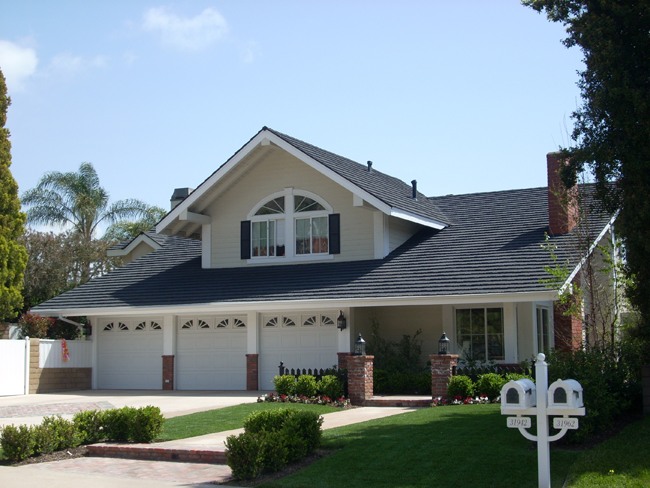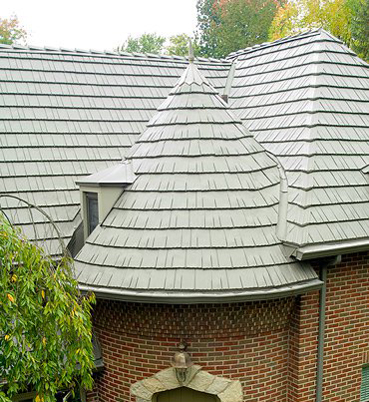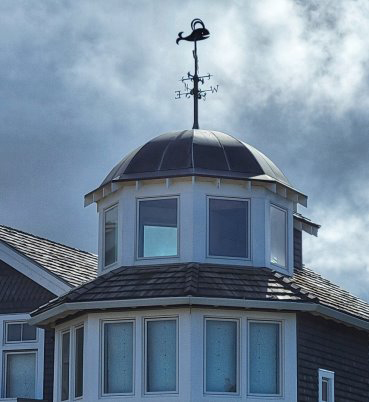What's Your Type: MRA Issues Primer On Metal Roofing Alloy Options
Submitted by the Metal Roofing Alliance
More homeowners are choosing metal roofing for their home...and for good reasons: Durable and protective against climate extremes, sustainable and energy efficient, stylish and long lasting are just a few of its benefits. But not all metal roofing is
created equal. The category actually consists of a wide range of different alloy types–all of which offer a variety of characteristics, costs and advantages–making it important for homeowners who are considering a new metal roof to understand
their options.
Below are the four most common metal roofing material types, along with what homeowners might expect when it comes to choosing among them:
 Stone coated steel also is a great option for homeowners who want the look of shake but the longer-lasting protection and value of metal.
Stone coated steel also is a great option for homeowners who want the look of shake but the longer-lasting protection and value of metal. 1) Steel: The Strong Standard
Steel is the most widely used metal roofing material and for good reason. Steel is an alloy made from iron and other elements, making it among the strongest metal options designed to weather even the harshest climate conditions, including high winds and
hail. It also can stand up to heavy snow and ice loads. Steel is typically the least expensive metal roofing option, yet thanks to advancements in quality paint systems and coatings, it comes in a huge array of different colors and can even mimic
copper, zinc and other material types such as clay tile, slate and shake. Quality steel roofing with a high-tech coating can last for up to 50-plus years, deliver energy efficient benefits and is a smart environmental choice given that steel is the
most recycled material on the planet.
But not all steel is not created equal. Homeowners can choose between galvanized steel, which is created using a layer of zinc to protect an inner layer of steel from corrosion, or Galvalume, which is similar to galvanized, but instead of using zinc,
it offers a protective combination of aluminum and zinc. That helps it achieve exceptional surface protection and a more uniform appearance. Stone coated steel also is a great option for homeowners who want the look of shake but the longer-lasting
protection and value of metal. Stone-coated steel roofing typically has a 24- or 26-gauge steel core that is coated with a layer of stone which is permanently adhered to the surface of the steel.
“Whether they are looking for great curb appeal or maximum performance in a variety of challenging climate conditions, steel is a terrific option for homeowners, which is why it is so popular in the U.S. and Canada. However, like all materials,
it’s important for homeowners to do their homework and select quality materials designed to meet strong standards that are manufactured by reputable metal roofing and coatings manufacturers,” said Renee Ramey, Executive Director of the
Metal Roofing Alliance (MRA).
 Copper is one of man's earliest-known metals and has been used as a roofing material for centuries, predominantly in Europe. It is regarded not only for its beauty, but longevity too.
Copper is one of man's earliest-known metals and has been used as a roofing material for centuries, predominantly in Europe. It is regarded not only for its beauty, but longevity too. 2) Copper The Strong Standard
Copper roofing has been used for centuries on some of the world’s most stunning homes and buildings. It is an extremely long-lasting and beautiful material, and it carries a high price tag to match. Copper will change appearance over time, and its
organic patination is one of the reasons why it is so prized for architectural roofing systems. One issue homeowners may experience depending on the region where they live, is staining from copper runoff. Copper also needs to be separated from other
metals as its natural compounds may speed up the corrosion of the metal it comes in contact with. For this reason, it’s important to work with a knowledgeable installer who has experience working with copper.
Because copper is easily soldered, it is particularly well-suited for low pitched roof. Using copper for unique roof designs, accents or special highlights can be a great way to incorporate the beauty of copper without the high expense of using it for
an entire roof.
 Aluminum roofing is a top choice in coastal climates.
Aluminum roofing is a top choice in coastal climates. 3) Aluminum: The Seaside Stalwart
Aluminum does a great job in coastal climates, thanks to its ability to resist salt corrosion. When subjected to oxygen, aluminum creates a layer of aluminum oxide which seals the inner layer of the metal to protect it from future corrosion and gives
it long lasting protection. Because of the way aluminum patinas, it is often treated with paint and protective coatings. It is typically more expensive (priced between steel and copper) and depending on how it is manufactured, aluminum panels have
a high strength-to weight ratio. A quality aluminum metal roof has a thicker profile than steel, offering excellent protection against severe weather and storms.
 Zinc roofing is beautiful and also exceptionally sustainable.
Zinc roofing is beautiful and also exceptionally sustainable. 4) Zinc: The Sustainable Stylist
With the ability to be easily formed and manipulated, zinc offers great flexibility for unique roof designs. It also can last for centuries and because it has a lower melting point, it is exceptionally sustainable. Zinc requires just one quarter of the
energy that it takes to process steel or copper and like other metals, it is also 100 percent recyclable. The cost of zinc is comparable to copper and because it is a softer metal, it may be subject to impact and large hailstone dings, depending on
the panel or shingle design. Keep in mind that zinc will react to its environment and change appearance over time if left bare. In fact, one of the most amazing properties of zinc is its patina that can heal scratches over time. However, one of the
drawbacks is that it is also subject to chalking effects, especially where water collects and flows. That’s why zinc roofing is typically sealed with a protective coating.
For more information about metal types, how to choose a quality metal roof designed to last for a lifetime, and additional details about metal roofing properties and performance capabilities, download a free copy of the MRA Metal Roofing Buyer’s
Guide at www.metalroofing.com.
About The Metal Roofing Alliance
 Representing metal roofing manufacturers in the United States and Canada, the Metal Roofing Alliance (MRA) was formed in 1998 as a
nonprofit organization to help educate consumers about the many benefits of metal roofs. The main objective of MRA is to increase awareness of the beauty, durability and money-saving advantages of quality metal roofs among homeowners, as well as to
provide support for metal roofing businesses and contractors. For more information, visit
metalroofing.com.
Representing metal roofing manufacturers in the United States and Canada, the Metal Roofing Alliance (MRA) was formed in 1998 as a
nonprofit organization to help educate consumers about the many benefits of metal roofs. The main objective of MRA is to increase awareness of the beauty, durability and money-saving advantages of quality metal roofs among homeowners, as well as to
provide support for metal roofing businesses and contractors. For more information, visit
metalroofing.com.




